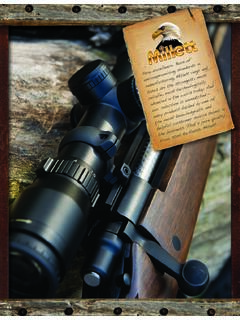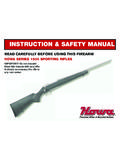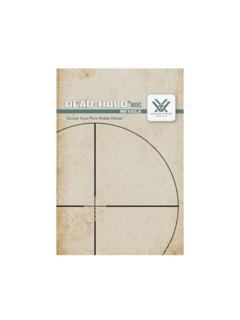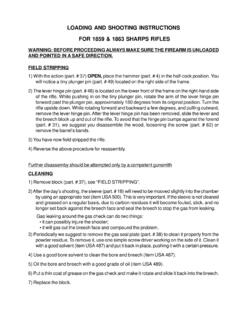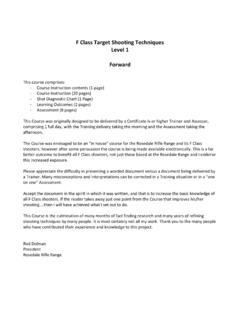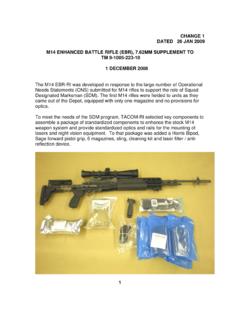Transcription of TRS-1 TRS-2 - MillettSights.com
1 TRS-1 TRS-2 Before starting, make sure firearm is UNLOADED!!INSTRUCTION and OPERATION TRS-1 TRS-2 TACTICAL rifle SCOPEI nstallation and use of Millett Tactical TRS-1 and TRS-2 scopes92-0027/02-10 MountingMounting your scope properly is important to the accuracy and durability of your firearm and scope. Proper mounting assures that the scope is aligned to the barrel and rigged to the rifle for the base and ring combination that you have chosen, make sure mounting screws for the base are firmly tightened. On most bolt action rifles, 50 to 60 inch pounds is suitable for the torque. Loctite is recommended to prevent the screws from loosening under recoil. Place the bottoms of the rings onto the base and center and tighten. Make sure ring bottom is aligned in the base and not cocked or out of line with the bore. failure to align the bottoms of the rings onto the base can damage the the scope into the bottoms of the rings, with the eyepiece to the rear, and align the crosshairs to the vertical and horizontal, moving the scope back and forth to get a full sight picture.
2 While looking through the scope, align the crosshairs and the eye relief. The eye relief on this model scope should be about 75mm or 3 the top caps of the rings on the bottoms and slightly tighten the screws. Check the alignment and eye relief before fully tightening the cap screws. TRS-1 scope mounted on a tactical rifle using Millett Angle-Loc rings and Picatinny is aligning the scope to the bore of the rifle to assist you in getting on target when sighting in the rifle . There are several ways to boresight a rifle : 1. Looking through the scope and the bore of the rifle until they are both at the same point. 2. Using an optical device inserted into the bore and aligning the scope to a point on the boresighter. 3. Using a laser inserted into the barrel at the muzzle or chamber to make a reference point and aligning the scope crosshairs to that point. All of these systems work well when the instructions supplied with each method are InSighting in your rifle is critical to assure that point-of-aim and impact yards are the same at a known range.
3 The method we recommend is to start shooting at 25 yards or 50 yards with a target large enough to allow some room for error. The goal of properly sighting in the scope is to eliminate human error, so use a solid rest to support the rifle . It s best if at the time you sight in, the wind is 3 shots, carefully holding the crosshairs at the same point on the target for each shot. Measure the distance from the point at which you were aiming to the center of the 3 shot group. This is how much you will need to move your scope to align the crosshairs. Note: The arrows on the turrets of the scope are for direction of movement of the bullet. Move the target to 100m or yards and repeat the sighting in procedure to adjust the turrets until the scope is aligned to the rifle . Fire a group of shots after adjustment to assure the proper sight-in. It is best to fire the rifle at the ranges that the sight will be using to assure your zero and drop for various ranges.
4 Many shooters set the sights a number of inches high at 100 yards so they have a longer point-blank range. Example: a 308 sighted 2 inches high at 100 yards will be dead on at 200 yards, extending the point-blank range to over 300 yards. Once the scope is sighted in, you can zero the windage and elevation turrets by loosening the 3 small set screws in the top of the caps and turning the cap until the zero ( 0 ) lines up with the dot on the body of the scope. Then, retighten the screws. Now, it s easy to count the clicks for elevation and windage. Note: Small Allen wrench in the features of the TRS ScopesThe TRS was designed to give the shooter the most useful features needed under the most demanding conditions. To get the full benefit of the features, it s best to learn their use before needing them. Try the different TRS features before you need them under varying of the CrosshairsOn the rear of the scope, there is a small knob that has markings from Off to 10.
5 This is your control for illumination of the crosshairs in low light or when you want a high contrast to the target. Use the lowest setting that still gives good visibility to the target and the crosshairs. NV is for use with Night Vision devices or under the lowest light battery life of the illumination is about 50 hours at the highest setting and over 150 hours for the lowest. Turn the illumination off when not in use. It s best to have a spare battery with you in the field in case a new battery is : When the illumination is turned on at night, it can be seen from directly in front of the scope, giving away your position. We recommend using the supplied lens shade and an anti-reflection device in combat situations. eye Piece FocusWindageelevationturret Lock RingsRange FocusZoom ControlIlluminator4 Turret LocksAn exclusive feature of the Millett TRS scopes, is the turret locks that prevent accidental movement of the windage and elevation adjustments of the scope.
6 By tightening the ring at the base of the turrets to the right, the adjustment is locked. Note: As the lock is positive, it is important to carefully adjust the turret when you have unlocked the ring. There may be some tension when first moving the turret. Do not try to over power the lock when the lock is tightened, as this may damage the Eye focusAt the rear of the scope, there is adjustment that is used to focus the crosshairs to your eyes. This is a diopter adjustment and is set from 2 + to diopter. Adjustment is made by rotating the rear ring. Adjust until the crosshairs are sharp to your eyes. Side Range focusOn the left side of the scope, there is a large knob that is used to remove parallax and to improve the focus of the scope at differing ranges. By turning the knob, you can adjust the scope s focus. Adjust until you have a sharp image of the target. The range marks may not be absolutely accurate due to your eyes, lighting conditions and other factors.
7 It s best to adjust the range focus for the best image and no parallax. Parallax can be seen if the crosshairs move from the point-of-aim when you shift your eye from side-to-side or up-and-down while looking through the scope. This will affect accuracy at longer RingOn the TRS-1 , you have a Zoom Ring that allows you to adjust the magnification of the scope for differing shooting conditions. The scope is variable from 4X to 16X power. The Mil-Dotbar is set to be 1 mil at 10X on the Zoom Ring. At this position, the Mil-Dot and Mil-Dotbar is inches at 100 yards. There is an indent at the 10X setting on the Zoom Ring to aid in finding this position. If your shooting requires the utmost accuracy, it is best to test fire the scope and weapon at various power settings to assure your zero and to see how the magnification affects your shooting accuracy. Sun ShadeThe Sun Shade helps to prevent glare and improves image in bright sunlight. Use care in screwing the Sun Shade into the scope body.
8 5 Mil-Dotbar ReticleMillett has developed the Mil-Dotbar reticle to assist the shooter in range-finding and hold-over at longer ranges. From the center of the Dot to the Bar is one mil, which is inches at 100 yards. The TRS-1 and TRS-2 scopes Mil-Dot bar is set for use at 10 X. On the TRS-1 , if you are not on 10 X power, you will have to adjust your measurement using the Mil-Dotbar chart below. At 500 yards, it s 18 inches and at 1000 yards, it s 36 inches. This measurement can be used to hold over for bullet drop, wind and moving targets. The dot is .75 inches in diameter at 100 yards which is also useful as a measuring device. The bar is .20 inches in thickness. By learning to use the Mil-Dotbar reticle, you will be able to judge range and shoot more accurately. See the range chart for more on the measurement of the system. See Chart 4 for a simple method of use of the Mil-Dotbar reticle. A good reference is Use of the TRS scopes and Mil-Dotbar at longer ranges If you sight your rifle in at 200 or 250 yards, it s possible to get good accuracy out to 600 yards by using the Mil-Dotbars to hold over.
9 For example, a 308 Win with a 168 gr bullet sighted in at 200 Yards is 54 inches low at 500 yards, which is a 3 Mil-Dotbar hold-over for dead-on impact. At 600, the drop is 92 inches and 1 mil equals inches, so 4 mils equals inches. Therefore, you need to come up 8 clicks as each click equals .75 1 MIL-DotbaR vaRIabLe sIZe to RaNge MIL-DotbaR sCaLe Power Setting 100 Yds. 4X 6X 8X 10X 12X 14X 16X .72 MOA ChaRt 2 tRs- 1 sPeCIFICatIoNs Power: 4X to 16X Length overall Inches: Objective lens: 50mm Mount length: Field-of-view ft at 100 yards: Weight: High 8 ft. Low 29 ft. Waterproof to 3 ft for 1min. Exit pupil diameter: Fog proof: -20 to 140F High power Windage and elevation adjustment: .25 MOA or .1 Mil Low power Battery: CR20032 Eye relief: Lenses: Full Multi-coat all surfaces Body Construction: One piece heat treated aluminum 30mm tube ChaRt 3 TRS-2 sPeCIFICatIoNs Power: 10X Length overall Inches: Objective lens: 50mm Mount length: Field-of-view ft at 100 yards: 18 ft.
10 Weight: 28oz Waterproof to 3 ft for 1min. Exit pupil diameter: 5mm Fog proof: -20 to 140F Windage and elevation adjustment: .25 MOA or .1 Mil Battery: CR20032 Eye relief: Lenses: Full Multi-coat all surfaces Body Construction: One piece heat treated aluminum 30mm tube ChaRt 4 MIL-DotbaR MethoD oF Use QUICK MILDot CaLCULatIoNs Meters .20 .30 .45 .50 .60 .91 Inches 9 12 18 20 24 36 Yards .250 .333 .500 .558 .667 3/4 333 444 666 741 889 1333 1 250 333 500 556 667 1000 1 1/4 200 266 400 445 534 800 1 1/2 167 222 333 371 445 667 1 3/4 143 190 285 318 381 571 2 125 167 250 278 334 500 2 1/4 111 148 222 247 296 444 2 1/2 100 133 200 222 267 400 2 3/4 91 121 182 202 243 364 3 83 111 167 185 222 333 3 1/4 77 102 154 171 205 308 3 1/2 71 95 143 159 191 286 3 3/4 67 89 133 148 178 267 4 63 83 125 139 167 2507 Reprint Courtesy of THE ULTIMATE SNIPER / Maj. John PlasterActual Object Height or WidthMeasured Height / Width in MilsCare of Your ScopeYour Millett TRS scope is designed to give many years of service in the most demanding of conditions, but it does require proper care and treatment.
